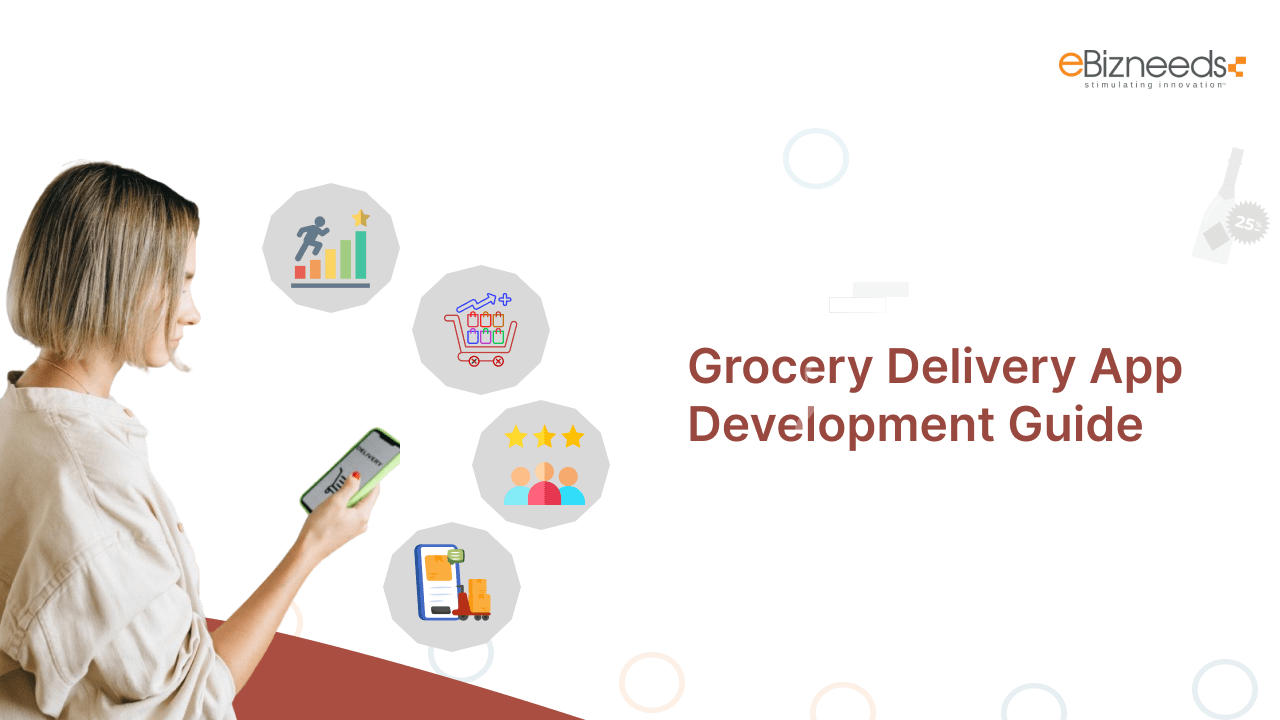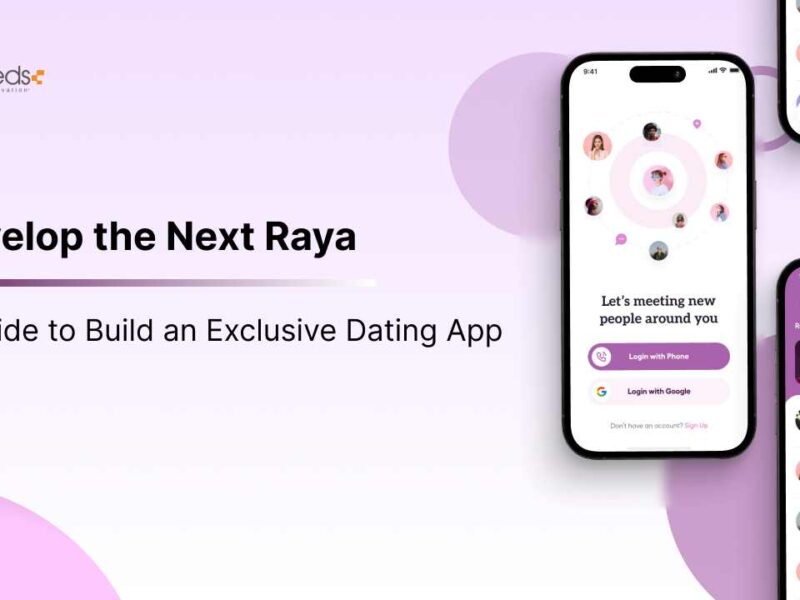Grocery delivery apps have revolutionized the shopping experience by offering unparalleled convenience.
In the U.S., the demand for these apps is skyrocketing as consumers increasingly prefer the ease of ordering groceries online and having them delivered to their doorstep.
This surge in popularity presents a unique opportunity for businesses to tap into a rapidly growing market.
Whether you’re a grocery chain aiming to expand your digital presence or a startup looking to break into the on-demand delivery space, building a grocery delivery app can be a game-changer.
This comprehensive grocery delivery app development guide takes you through the essentials of grocery delivery app development, including market insights, must-have features, cost breakdowns, and the latest technological trends.
By the end of this guide, you’ll have a clear roadmap to creating a successful grocery delivery app that stands out in a competitive market.
Let’s get started!
Grocery Delivery App Market Insights: Key Statistics for 2025
The grocery delivery market is experiencing significant growth, driven by changing consumer behaviors and technological advancements.
Here are some key statistics highlighting the industry’s potential:
- The worldwide grocery delivery market is projected to grow from $770.90 billion in 2024 to $1,347.00 billion by 2029, with a CAGR of 11.81%.
- In 2022, approximately 54% of Americans aged 18 and above, totaling 141.7 million individuals, preferred shopping for groceries online.
- Globally, the average revenue per user in the grocery delivery sector is estimated at $183.40 in 2024.
- Venture capital investments in rapid grocery delivery services totaled $14 billion in 2021, indicating strong investor confidence in the sector.
- Online grocery sales in the United States are expected to reach $257.5 billion in 2024, with projections indicating an increase to $364 billion by 2026.
- The number of users in grocery delivery market is projected to reach 263.8 million by 2029, with a user penetration rate of 11.6% in 2024.
- The global online grocery market is expected to reach $1.1 trillion by 2022.
- In China, Meituan and Ele.me control about 90% of the food delivery market, with Meituan contributing approximately $38 billion to the country’s $46.6 billion market size in 2023.
These statistics underscore the dynamic growth and evolving landscape of the grocery delivery industry, presenting significant opportunities for businesses and developers in this space.
What Is a Grocery Delivery App? Exploring the Concept and Functionality
A grocery delivery app is a platform designed to transform the way people shop for groceries.
It connects users with local or online grocery stores, enabling them to order essential items conveniently from their smartphones.
With just a few taps, users can browse product categories, compare prices, and place orders, while the app handles everything from payment processing to delivery logistics.
These apps typically cater to two key stakeholders:
• End-users (Customers): Enjoy a seamless shopping experience with features like order customization, scheduled deliveries, and real-time order tracking.
• Business Owners (Admin/Stores): Gain tools to manage inventory, handle payments, and optimize delivery routes, all within a single interface.
A grocery delivery app is not just about convenience, it’s a tool for creating efficiency.
For users, it saves time and eliminates the need for physical store visits.
For businesses, it offers access to a wider customer base and provides insights into buying patterns to optimize operations.
Whether you’re a small grocery store or a large retailer, investing in a grocery delivery app helps you stay relevant in a world where digital solutions are becoming indispensable.
How Do Grocery Delivery Apps Work?
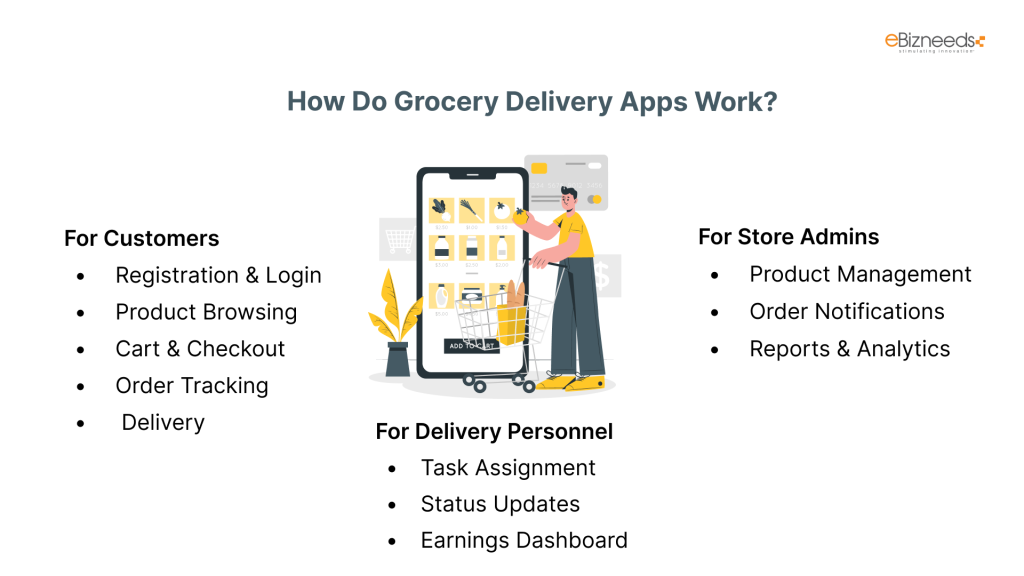


Building a grocery delivery app involves creating a seamless experience for users, store owners, and delivery personnel.
Here’s how a typical grocery delivery app operates:
For Customers
1. Registration & Login: Users sign up and create accounts using their email, phone numbers, or social media profiles.
2. Product Browsing: Customers explore categorized product lists with prices and availability.
3. Cart & Checkout: Selected items are added to the cart, followed by a checkout process with multiple payment options.
4. Order Tracking: Users receive real-time updates on their order status, including estimated delivery time.
5. Delivery: Items are delivered to the doorstep as per the scheduled time.
For Store Admins
1. Product Management: Admins upload and update inventory details, pricing, and promotional offers.
2. Order Notifications: The app sends alerts for every new order, helping manage processing efficiently.
3. Reports & Analytics: Access sales data, user trends, and delivery performance through a dashboard.
For Delivery Personnel
1. Task Assignment: Delivery agents receive tasks via the app with optimized routes for faster delivery.
2. Status Updates: They update the delivery status for transparency.
3. Earnings Dashboard: View earnings and completed deliveries in the app.
The grocery delivery app ecosystem combines user-friendly interfaces with powerful back-end systems to deliver an efficient and satisfying experience for all stakeholders.



Types of Grocery Delivery Apps and Their Features
The grocery delivery app industry is diverse, catering to different business models and customer preferences.
Here’s a detailed look at the various types of grocery delivery apps, tailored for the U.S. market, along with their features and examples:
1. Single-Store Grocery Delivery Apps
These apps are created for individual grocery stores aiming to extend their services online.
Popular among local stores and supermarket chains, single-store grocery delivery apps help businesses directly connect with their customers.
Features
• Inventory management with real-time updates
• Delivery scheduling based on customer convenience
• In-app promotions, coupons, and loyalty programs
Examples
• Trader Joe’s (app allows direct ordering and local delivery)
• Safeway (enables easy online shopping and doorstep delivery)
For single-store businesses, this app type is an excellent way to increase their market reach and retain loyal customers.
2. Multi-Store Marketplace Apps
These apps aggregate multiple grocery stores on a single platform, offering customers the convenience of browsing and comparing products from different vendors.
They serve as a one-stop shop for diverse grocery needs.
Features
• Price and product comparison between stores
• Real-time inventory updates to avoid out-of-stock items
• Multiple payment methods, including eWallets and credit cards
Examples
• Instacart (partners with local stores like Costco, Kroger, and Target to provide same-day delivery)
• Shipt (offers delivery from major stores like CVS and Kroger across the U.S.)
Such apps are particularly popular in metropolitan areas where customers seek convenience and variety.
3. Hyperlocal Grocery Delivery Apps
Hyperlocal apps focus on delivering groceries from stores within a specific geographic radius.
These apps prioritize speed and cater to the “need-it-now” culture prevalent in U.S. cities.
Features
• Geo-based store listing for location-specific options
• Route optimization for fast delivery
• Instant order placement with real-time tracking
Examples
• GoPuff (delivers snacks, beverages, and household items in under 30 minutes)
• DashMart (a service by DoorDash, focused on grocery delivery in local neighborhoods)
Hyperlocal apps are ideal for urban areas where same-day delivery is a key selling point.
4. Subscription-Based Grocery Apps
Subscription-based apps are designed for customers who regularly purchase specific groceries.
They offer recurring delivery services, often with discounts and added perks for subscribers.
Features
• Customizable subscription plans for weekly or monthly deliveries
• Automatic order placements based on customer preferences
• Exclusive discounts and free delivery for members
Examples
• Amazon Fresh (offers Prime members fast delivery on fresh produce and household staples)
• FreshDirect (provides subscription plans for regular grocery deliveries in cities like New York and Washington, D.C.)
These apps are a favorite among busy families and working professionals in the U.S.
5. Aggregator Grocery Delivery Apps
Aggregator apps act as intermediaries, directing users to stores’ websites or apps for order placement.
They provide a unified platform for browsing without directly handling the inventory or delivery.
Features
• Centralized platform for browsing multiple stores
• Redirection to individual stores’ ordering systems
• User reviews and ratings for each store
Examples
• BigBasket USA (aggregates stores while redirecting customers for final checkout)
• Peapod (a legacy app offering connections to various local grocery stores)
These apps are best suited for businesses looking to build visibility without managing delivery logistics.
By understanding these types of grocery delivery apps and their features, you can determine the model that best fits your business objectives.
The U.S. market presents a unique opportunity with its diverse demographics and growing demand for online grocery services.
Investing in the right app type can ensure long-term growth and customer satisfaction.
Grocery Delivery Apps vs. Food Delivery Apps: Key Differences
Though both grocery delivery apps and food delivery apps provide convenience to users, they cater to different needs and operational workflows.
Understanding their distinctions is crucial, especially for businesses considering investment in app development.
Here’s a detailed comparison to help clarify their differences:
| Aspect | Grocery Delivery Apps | Food Delivery Apps |
| Purpose | Deliver groceries, household items, and pantry essentials. | Deliver ready-to-eat meals from restaurants. |
| Target Users | Families, individuals stocking up on weekly essentials. | Individuals seeking quick, cooked meals or dining options. |
| Product Range | Fresh produce, packaged goods, and household supplies. | Restaurant-prepared meals, snacks, and beverages. |
| Delivery Time | Scheduled or same-day delivery for bulk or weekly orders. | Instant delivery, usually within 30–60 minutes. |
| Order Frequency | Typically weekly or bi-weekly. | Often daily or multiple times a week. |
| Examples | Instacart, Amazon Fresh, Shipt. | DoorDash, Uber Eats, GrubHub. |
| Revenue Model | Delivery fees, subscription plans, partner commissions. | Delivery fees, restaurant commissions, and ads. |
| Operational Workflow | Requires warehouses, store integration, and inventory tracking. | Relies on restaurant partnerships and menu listings. |
While grocery delivery apps focus on fulfilling essential, large-scale household needs, food delivery apps cater to immediate consumption and convenience. For instance:
• Grocery delivery apps like Instacart allow customers to plan weekly meals by ordering ingredients in bulk.
• Food delivery apps such as Uber Eats target users looking for hassle-free dining without cooking.
Why Choose Grocery Delivery Apps?
Grocery delivery apps hold a significant edge in providing long-term value to users who prioritize health, budgeting, and meal planning.
With more families and health-conscious consumers in the U.S. embracing home-cooked meals, the demand for grocery delivery is expected to grow exponentially.
Why Should You Invest in Grocery Delivery App Development?
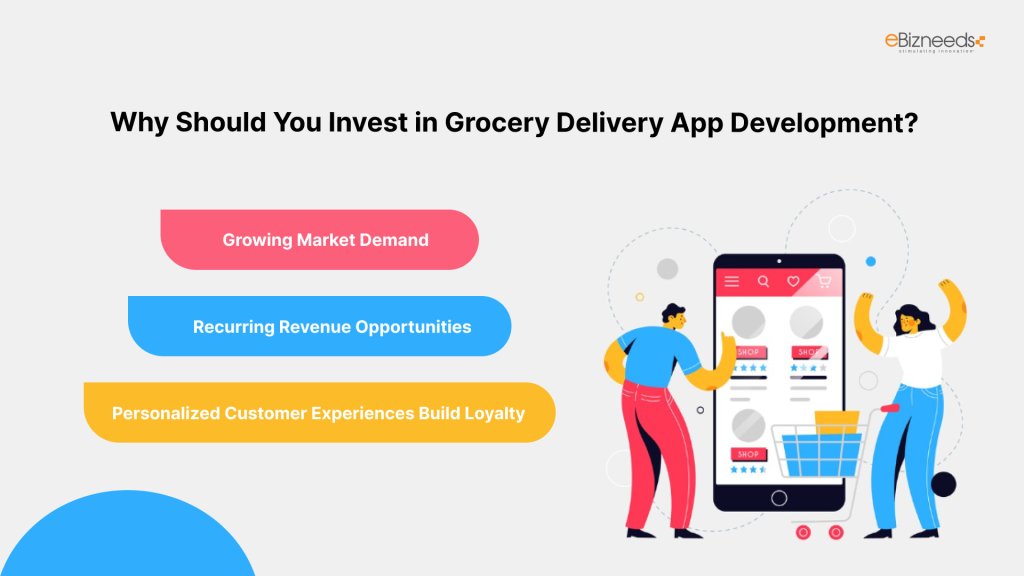


The grocery delivery market has seen tremendous growth over the past few years.
Here, the convenience of doorstep delivery has become a staple for millions of households.
If you are considering entering this market, here are three detailed reasons why developing a grocery delivery app is a promising investment.
Growing Market Demand
The demand for grocery delivery services has skyrocketed, with over 54% of U.S. consumers shopping for groceries online in 2022 alone.
This trend is not limited to urban areas; even suburban and rural regions are increasingly adopting online grocery shopping.
Major cities like New York, Los Angeles, and Chicago have shown exponential growth due to busy lifestyles and a shift toward digital convenience.
This surge presents a golden opportunity for businesses to cater to a market that continues to expand.
Developing a grocery delivery app allows you to tap into this growing audience, providing them with a seamless shopping experience while building your brand presence.
Recurring Revenue Opportunities
Unlike other app categories that may rely on one-time purchases or sporadic usage, grocery delivery apps benefit from recurring revenue.
Most households in the U.S. purchase groceries weekly or bi-weekly, ensuring consistent usage of the app.
Moreover, introducing subscription models, such as those used by Amazon Fresh or Walmart+, can provide a steady stream of income.
Additional revenue channels, such as delivery fees, advertisements, and partnerships with local grocery stores, further boost profitability.
With the right pricing strategy and features, your app can generate continuous income while ensuring customer retention.
Personalized Customer Experiences Build Loyalty
Consumers in the U.S. are becoming increasingly accustomed to personalized services, and grocery delivery apps excel in offering tailored experiences.
By analyzing user behavior and purchase history, apps can recommend products, provide discounts on frequently bought items, and offer flexible delivery options.
For instance, apps like Instacart and Shipt have perfected the art of customer retention by integrating features like real-time delivery tracking and order customization.
A grocery delivery app that prioritizes user preferences not only enhances customer satisfaction but also fosters long-term loyalty, ensuring repeat business.
By investing in a grocery delivery app, you’re stepping into a market with immense potential for growth, recurring revenue streams, and opportunities to create a loyal customer base.
This is the perfect time to position your business as a leader in this thriving industry.
Who Should Build a Grocery Delivery App?
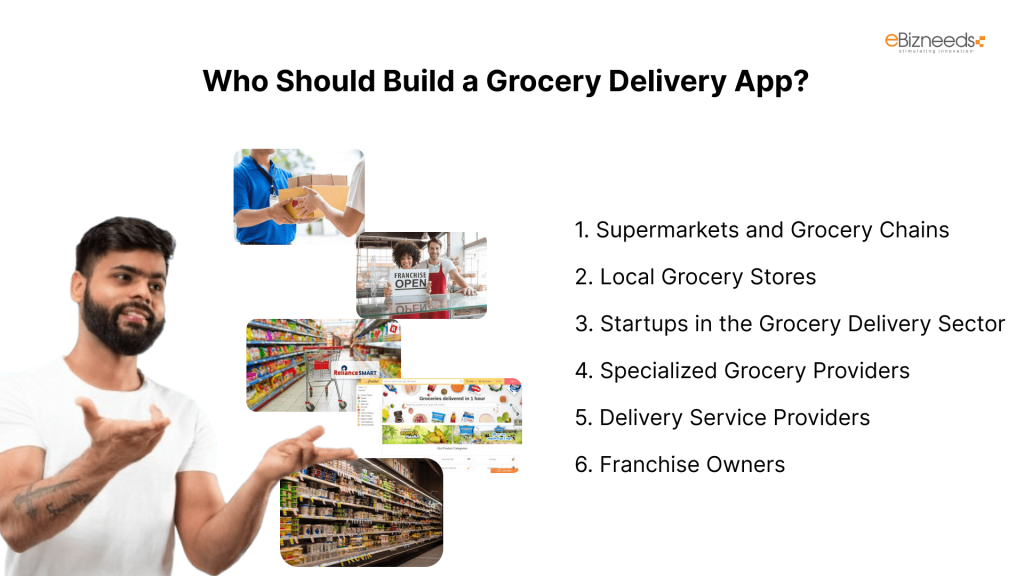


The grocery delivery market offers immense potential, but it’s important to determine whether investing in a grocery delivery app aligns with your business goals.
Here’s a detailed look at the types of businesses that can benefit most from developing such an app:
1. Supermarkets and Grocery Chains
Large supermarket chains like Walmart, Whole Foods, and Kroger have already embraced grocery delivery apps, but smaller regional chains can also benefit.
• If you own or manage a supermarket, a grocery delivery app allows you to cater to digital-savvy consumers who prefer shopping online.
• It can help you compete with established brands by providing a seamless delivery experience.
2. Local Grocery Stores
Independent grocery stores that primarily serve local communities are prime candidates for grocery delivery app development.
• An app enables these stores to expand their reach, attract new customers, and retain existing ones.
• With features like local promotions and hyperlocal delivery, small businesses can thrive in an increasingly digital landscape.
3. Startups in the Grocery Delivery Sector
Entrepreneurs and startups looking to enter the on-demand delivery space should seriously consider grocery delivery apps.
• Building an app that serves as a multi-vendor marketplace, like Instacart or Shipt, allows you to connect users with various stores, offering greater variety and convenience.
• This model not only generates revenue through delivery fees but also creates opportunities for partnerships with grocery retailers.
4. Specialized Grocery Providers
Businesses focusing on niche grocery categories, such as organic food, vegan products, or ethnic groceries, can use apps to target specific audiences.
• For example, an app focusing on organic products could attract health-conscious customers who are willing to pay a premium for convenience and quality.
5. Delivery Service Providers
Companies already in the logistics or delivery industry can expand their services to include grocery delivery.
• With an established delivery network, adding grocery services to your offerings could be a cost-effective way to increase revenue streams.
6. Franchise Owners
Franchise businesses operating in the food and grocery sector can build apps to standardize delivery services across multiple locations, ensuring a consistent customer experience.
The U.S. grocery delivery market is at its peak, with digital grocery shopping becoming the norm rather than the exception.
Whether you’re a large retailer or a budding entrepreneur, investing in a grocery delivery app can help you stay competitive, attract new customers, and build a sustainable business in an ever-growing industry.
Step-by-Step Guide to Grocery Delivery App Development
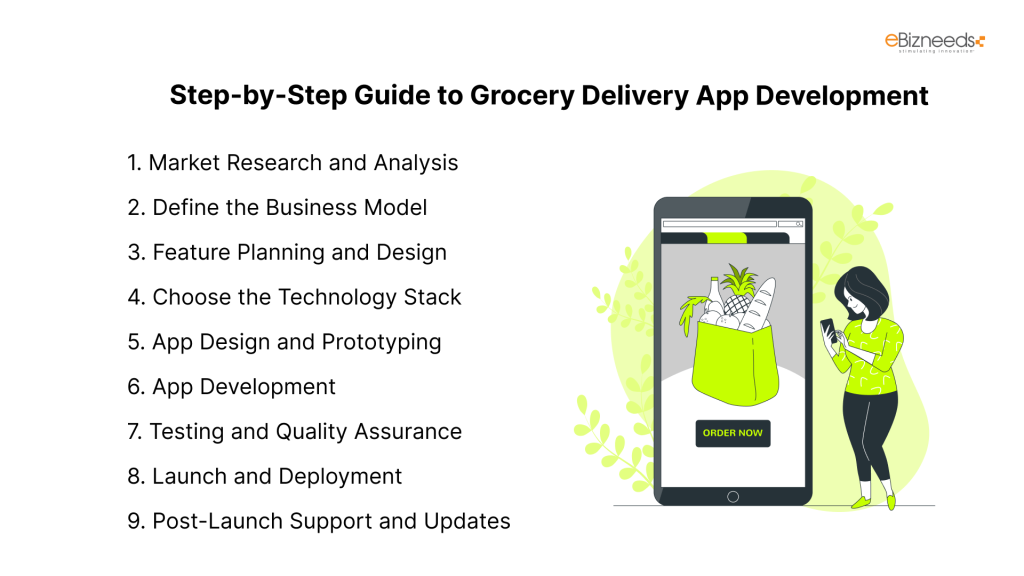


Creating a grocery delivery app requires a meticulous approach, balancing user experience, business goals, and technology integration.
Below is a super-detailed guide to help you navigate the process.
1. Market Research and Analysis
Before diving into development, start with comprehensive market research.
Identify your target audience based on demographics like age, income, and location.
For example, busy urban professionals and families with children are key users of grocery delivery apps in the U.S. Analyze competitors such as Instacart, Shipt, and Amazon Fresh to understand their strengths and weaknesses.
Research customer pain points like lack of delivery options, high service charges, or delays.
Also, explore regional grocery preferences, which can help you localize your offerings.
This groundwork ensures your app meets market demands while addressing gaps left by competitors.
2. Define the Business Model
Choosing the right business model is essential to your app’s success.
If you own a grocery chain, a single-store model lets you focus on your specific store’s inventory and services.
If you’re an entrepreneur, consider a marketplace model to aggregate multiple stores, offering users variety and flexibility.
For example, Instacart connects users to local stores, earning revenue through partner commissions and delivery fees.
Another lucrative option is a subscription-based model like Amazon Fresh, which builds a loyal customer base through membership perks.
Your chosen model will shape everything from app design to monetization strategies.
3. Feature Planning and Design
An effective grocery delivery app must cater to customers, admins, and delivery personnel with distinct features.
For customers, include user-friendly registration, product search, multi-payment options, and order tracking.
Admins require robust tools for inventory updates, order processing, and analytics.
Delivery agents need optimized routes, earnings dashboards, and real-time order updates.
Beyond the essentials, advanced features like voice search, AI-based product recommendations, and chat support can elevate your app.
For example, Shipt uses intuitive search options to simplify shopping, while Amazon Fresh leverages AI for personalized suggestions, keeping users engaged.
4. Choose the Technology Stack
Your app’s technology stack determines its scalability, speed, and user experience.
This goes way beyond choosing a platform between android app development and iOS app development.
| Component | Recommended Technologies | Purpose |
| Frontend Development | React Native, Flutter, Swift (iOS), Kotlin (Android) | Create a responsive and user-friendly interface across devices. |
| Backend Development | Node.js, Ruby on Rails, Django | Handle server-side logic, data processing, and integration with the database. |
| Database | MongoDB, PostgreSQL, MySQL, Firebase | Store and manage app data, including user information, product listings, and order history. |
| Payment Gateway | Stripe, PayPal, Square | Enable secure and seamless payment transactions. |
| Geolocation | Google Maps API, Mapbox | Provide location-based services, such as store listing and optimized delivery routes. |
| Push Notifications | Firebase Cloud Messaging (FCM), OneSignal | Keep users updated with order status, promotions, and app notifications. |
| Real-Time Analytics | Google Analytics, Mixpanel, Firebase Analytics | Track user behavior, app performance, and engagement metrics. |
| Cloud Hosting | AWS (Amazon Web Services), Google Cloud, Microsoft Azure | Host the app backend, ensuring scalability and reliability. |
| Authentication | OAuth, Firebase Authentication, Auth0 | Secure user login and data access with multi-factor authentication. |
| APIs | Twilio (SMS notifications), Nexmo (communication), OpenAI APIs | Integrate additional services like communication, advanced search, or customer support systems. |
5. App Design and Prototyping
Design is the cornerstone of a great user experience.
Begin with wireframes to outline app layouts, ensuring intuitive navigation for users.
Tools like Figma or Adobe XD can help visualize the interface.
Focus on a clean design with clearly labeled categories, easy-to-access filters, and seamless checkout processes.
For example, Instacart groups products into intuitive categories, enhancing discoverability.
Conduct usability testing on prototypes to gather feedback before development begins.
A user-friendly design not only improves customer satisfaction but also encourages repeat usage, which is vital in the competitive grocery delivery market.
6. App Development
This phase involves transforming your designs into a fully functional app.
Frontend developers build the user interface, ensuring responsiveness across devices.
Backend developers handle app logic, integrating features like real-time order tracking and notifications.
Use APIs to connect essential services like payment gateways, geolocation, and SMS notifications.
For instance, Twilio APIs enable automated text updates about order status. During development, prioritize scalability to accommodate growth.
Agile development methodologies allow you to build incrementally, testing and improving features along the way.
This iterative process ensures that the final app meets both user and business needs.
7. Testing and Quality Assurance
Rigorous testing ensures your app is bug-free and delivers a smooth experience.
Conduct functional testing to check features like search, payment, and tracking. Use performance testing to ensure the app runs efficiently, even with high user loads.
For example, simulate peak order times to see if the app maintains speed and accuracy.
Security testing is equally important to protect sensitive user data, such as payment details and addresses.
Automation tools like Selenium or manual testing techniques can uncover potential issues.
Launch a beta version for a select audience to gather real-world feedback before the official launch.
8. Launch and Deployment
Once testing is complete, prepare your app for deployment.
Submit it to app stores like Google Play and Apple App Store, ensuring compliance with their guidelines.
Create compelling app descriptions and use screenshots to showcase key features.
A soft launch in a smaller market can help identify last-minute improvements. Partner with influencers, run targeted ads, and use email campaigns to create buzz.
Monitor user feedback post-launch and address concerns quickly.
A successful launch combines technical readiness with strategic marketing, ensuring your app gains traction from the start.
9. Post-Launch Support and Updates
Your work doesn’t end with the app’s launch.
Regular maintenance & updates keep the app relevant and competitive.
Address bugs reported by users promptly to maintain trust. Use analytics tools like Google Analytics or Firebase to track user behavior, identifying areas for improvement.
Introduce new features based on feedback or industry trends, such as contactless delivery or loyalty rewards.
Effective post-launch support not only retains existing users but also attracts new ones through positive reviews and word-of-mouth recommendations.
Continuous optimization is key to long-term success in the grocery delivery market.
This detailed approach ensures your app is robust, user-friendly, and ready to capture a growing market.
Cost to Develop a Grocery Delivery App
The cost of developing a grocery delivery app depends on several factors, including the app’s complexity, design, features, and the location of the development team.
On average, the app development cost ranges between $40,000 and $150,000.
For a basic app with minimal features and a simple design, the cost typically falls between $40,000 and $70,000.
If you opt for a mid-level app with advanced features such as order tracking, personalized recommendations, and an enhanced user interface, you can expect the cost to rise to $70,000–$120,000.



For enterprise-level apps that include custom features, integrations with third-party APIs, and scalability for high user volumes, the cost can exceed $150,000.
| Cost Component | Description | Estimated Cost |
| App Design | Includes wireframes, UI/UX design, and prototypes. | $5,000–$15,000 |
| Frontend & Backend Development | Covers coding for the user interface and server-side functionality. | $20,000–$50,000 |
| Third-Party Integrations | Payment gateways, geolocation, notifications, and analytics APIs. | $3,000–$10,000 |
| Testing & Quality Assurance | Ensures bug-free operation and smooth user experience. | $5,000–$10,000 |
| Deployment | Publishing the app on app stores and backend setup. | $2,000–$5,000 |
| Post-Launch Maintenance | Monthly updates, bug fixes, and server management. | $1,000–$5,000 per month |
The development region also plays a significant role in determining costs.
Developers in the U.S. or Canada typically charge $100 to $150 per hour, while rates in Europe range from $50 to $100 per hour, and in Asia, particularly India, rates are significantly lower at $20 to $50 per hour.
By choosing the right development partner and prioritizing essential features during the initial phase, you can manage costs effectively while delivering a high-quality app.
If you’re considering a grocery delivery app, understanding these cost dynamics helps in planning a budget that aligns with your business goals and user expectations.
For more details, it’s highly recommended that you consult an app development company.
Essential and Advanced Features of a Grocery Delivery App
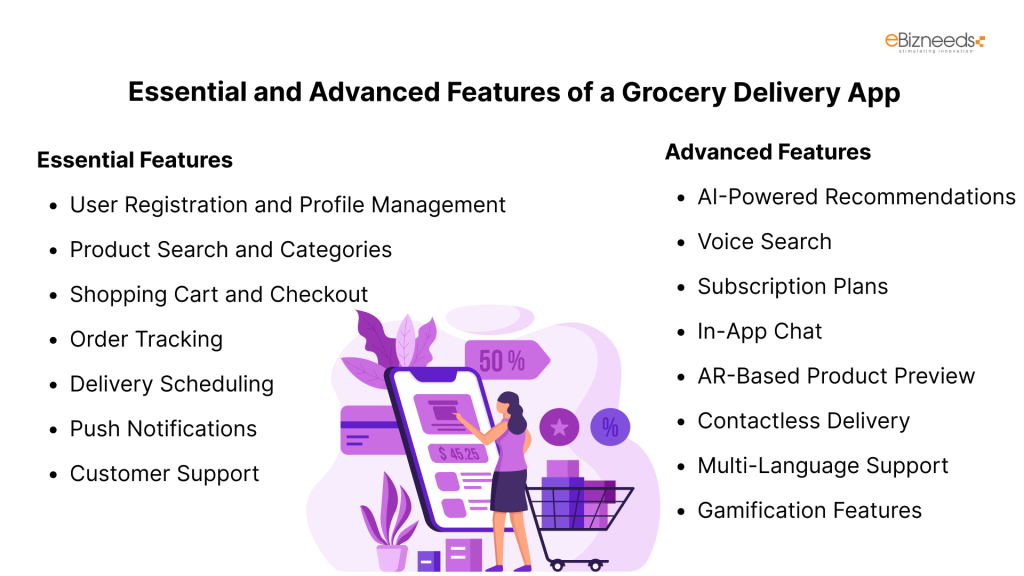


A successful grocery delivery app combines essential features.
This ensure a seamless shopping experience with advanced features that enhance user engagement and differentiate your app in the competitive market.
Below is a detailed overview of the features that should be included in your app.
Essential Features
1. User Registration and Profile Management: Allow users to create accounts using email, phone numbers, or social media. A detailed user profile helps provide personalized recommendations, order history, and a seamless checkout experience.
2. Product Search and Categories: Enable users to browse products by categories like fresh produce, dairy, or snacks. Include search filters for brands, price range, and dietary preferences to improve discoverability.
3. Shopping Cart and Checkout: A robust cart functionality lets users review items, adjust quantities, and proceed with an easy checkout. Multiple payment options such as credit cards, PayPal, and digital wallets ensure flexibility.
4. Order Tracking: Real-time tracking allows customers to monitor their orders from placement to delivery. Notifications about delivery time updates or delays enhance the user experience.
5. Delivery Scheduling: Give users the flexibility to choose their preferred delivery time, catering to their convenience. For instance, apps like Instacart offer same-day or scheduled delivery options.
6. Push Notifications: Keep users informed about order updates, discounts, and promotions. Timely notifications can significantly boost user engagement.
7. Customer Support: Integrate chatbots or a support helpline to assist users with queries or complaints, ensuring a high level of customer satisfaction.
Advanced Features
1. AI-Powered Recommendations: Leverage artificial intelligence to suggest products based on user preferences, purchase history, and trends. This feature, used by apps like Amazon Fresh, drives repeat purchases.
2. Voice Search: Integrate voice recognition to allow users to search for products or add items to their cart hands-free, making the shopping process more accessible and efficient.
3. Subscription Plans: Offer subscription-based benefits such as free delivery, exclusive discounts, or priority support to build customer loyalty.
4. In-App Chat: Enable users to communicate with delivery personnel for real-time updates or instructions, improving transparency.
5. AR-Based Product Preview: Augmented reality allows users to preview products, especially fresh produce, before purchasing, ensuring quality and customer satisfaction.
6. Contactless Delivery: Provide an option for contactless delivery, allowing customers to receive groceries without direct interaction a popular feature in post-pandemic times.
7. Multi-Language Support: Support multiple languages to cater to diverse user demographics, especially in multilingual markets like the U.S.
8. Gamification Features: Incorporate reward points, badges, or streaks for frequent purchases to keep users engaged and incentivized.
By incorporating these essential and advanced features, your grocery delivery app can offer a superior user experience, boost engagement, and stand out in a competitive market.
Monetization Strategies for Grocery Delivery Apps
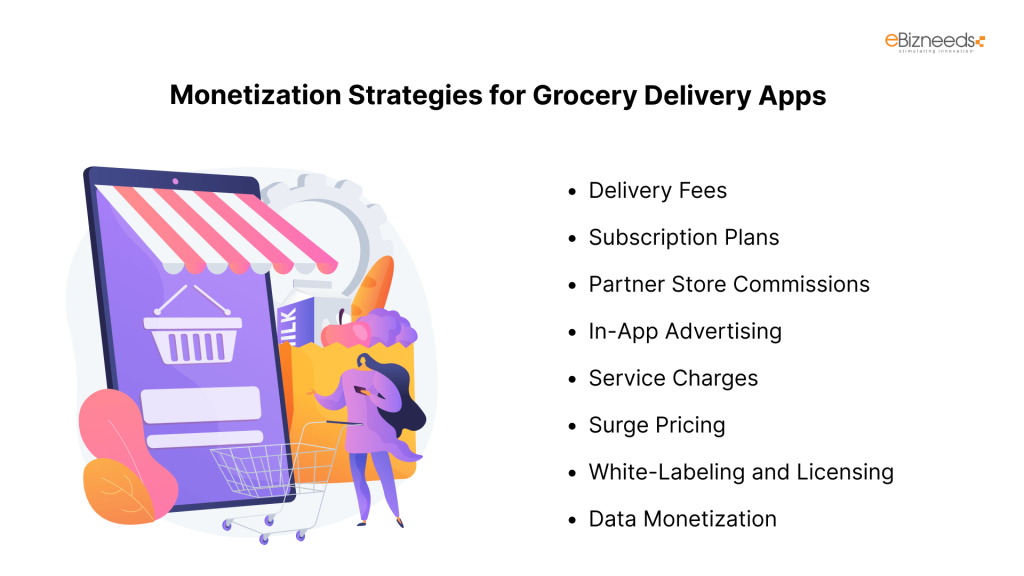


Building a grocery delivery app isn’t just about creating convenience for users, it’s also about generating sustainable revenue.
Here are some of the most effective monetization strategies tailored to the grocery delivery industry:
1. Delivery Fees
Charging customers a delivery fee is one of the most straightforward ways to generate revenue.
Many apps, like Instacart and Shipt, implement variable fees based on factors such as order size, delivery speed, and distance.
For instance, customers who require same-day delivery may be charged higher fees compared to those scheduling deliveries in advance.
By offering free or discounted delivery for orders above a certain amount, apps can also encourage larger purchases.
2. Subscription Plans
Subscription models are increasingly popular in the U.S. market.
Apps like Amazon Fresh and Walmart+ offer premium memberships that include benefits like free delivery, exclusive discounts, and early access to deals.
Subscriptions not only ensure steady revenue but also build a loyal customer base.
For example, charging $10–$15 per month for unlimited free deliveries can attract frequent users.
3. Partner Store Commissions
Apps that follow a multi-store marketplace model, such as Instacart, generate revenue by charging partner stores a commission on every sale made through the app.
This typically ranges between 10–30% of the order value.
Partnering with local grocery stores also helps apps expand their product offerings while benefiting from additional income streams.
4. In-App Advertising
In-app advertisements are a lucrative monetization strategy, especially for apps with high user traffic.
Brands can pay for premium placements to promote their products, offering them visibility at the top of search results or featured categories.
Grocery delivery apps can also collaborate with FMCG companies to showcase sponsored products or run targeted campaigns based on user preferences.
5. Service Charges
Adding a small service fee to each transaction is another way to boost revenue.
Unlike delivery fees, service charges are often used to cover operational costs such as app maintenance, customer support, and payment processing.
This fee is usually nominal (e.g., 5–10% of the order total) but contributes significantly when scaled across multiple orders.
6. Surge Pricing
Adopting a dynamic pricing model during peak hours or high-demand seasons, such as holidays or weekends, can significantly increase revenue.
For example, during Thanksgiving or Christmas, delivery fees can be adjusted to reflect the increased demand, incentivizing customers to plan their orders in advance.
7. White-Labeling and Licensing
For businesses looking to generate additional income, white-labeling their app platform and licensing it to smaller grocery stores or startups can be a profitable venture.
This allows other businesses to use your technology while you earn revenue through licensing fees.
8. Data Monetization
Analyzing user behavior and purchase trends can provide valuable insights for third-party brands and suppliers.
Apps can offer anonymized data to FMCG companies, enabling them to optimize inventory, pricing, and promotional strategies.
However, it’s crucial to maintain compliance with data privacy regulations, such as GDPR and CCPA, when implementing this strategy.
The grocery delivery app market is highly profitable, with major players generating billions annually.
By implementing multiple monetization strategies, your app can secure diverse revenue streams and maximize ROI.
For instance, combining subscription plans, advertising, and partner commissions can ensure both short-term gains and long-term sustainability.
Emerging Technology Trends in Grocery Delivery App Development
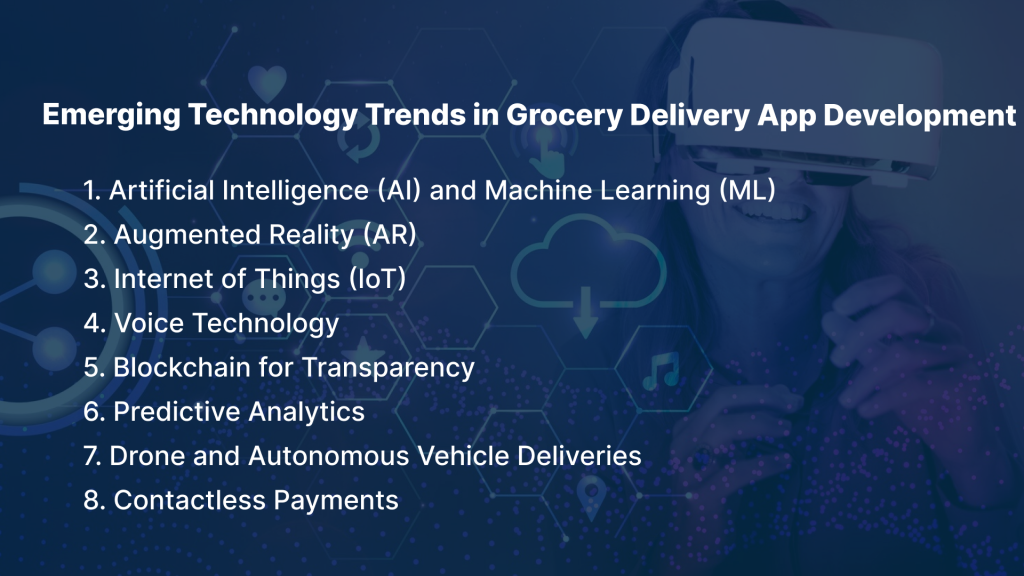


The grocery delivery app market is evolving rapidly, driven by advancements in technology and changing consumer demands.
Staying ahead of these trends is essential for building competitive and innovative apps.
Here are the top technology trends shaping the future of making a grocery delivery app, along with practical applications for each.
1. Artificial Intelligence (AI) and Machine Learning (ML)
AI and ML technologies enable personalized shopping experiences and operational efficiency by analyzing user data and automating processes.
Applications
• AI-powered recommendation engines suggest products based on user preferences and purchase history.
• ML algorithms optimize delivery routes to minimize costs and reduce delivery times.
• AI chatbots provide instant customer support, improving user satisfaction.
2. Augmented Reality (AR)
AR enhances user engagement by offering interactive and realistic shopping experiences directly through the app.
Applications
• AR tools allow users to preview fresh produce and inspect quality before purchase.
• Virtual store tours recreate the in-store shopping experience online.
• Visualization of product sizes and placement helps customers make informed choices.
3. Internet of Things (IoT)
IoT connects physical and digital systems, streamlining inventory management, and ensuring product quality during delivery.
Applications
• Smart shelves automatically update app inventory when products are added or removed.
• IoT-enabled vehicles monitor and maintain temperature for perishable goods.
• Connected devices provide real-time updates on order status and delivery tracking.
4. Voice Technology
Voice-enabled apps improve accessibility and convenience by allowing users to perform tasks hands-free.
Applications
• Voice commands enable users to search for items, add them to the cart, and complete purchases.
• Integration with smart assistants like Alexa or Google Assistant simplifies reordering groceries.
• Voice-guided navigation helps delivery personnel optimize routes.
5. Blockchain for Transparency
Blockchain technology ensures end-to-end transparency, building trust with customers by verifying product authenticity.
Applications
• Track the journey of organic or specialty products from farm to table.
• Provide tamper-proof records of food safety inspections.
• Guarantee authenticity for premium or imported grocery items.
6. Predictive Analytics
Predictive analytics tools help grocery delivery apps forecast demand, reducing waste and improving inventory management.
Applications
• Analyze seasonal trends to stock high-demand items in advance (e.g., Thanksgiving turkey or holiday sweets).
• Identify and recommend frequently purchased products to customers.
• Optimize warehouse storage by predicting inventory turnover rates.
7. Drone and Autonomous Vehicle Deliveries
Drone and autonomous delivery solutions are transforming logistics by offering faster and more efficient delivery options.
Applications
• Drones deliver small grocery orders to urban or hard-to-reach areas within minutes.
• Autonomous vehicles reduce the need for human drivers, cutting operational costs.
• Delivery robots navigate sidewalks for short-distance deliveries in densely populated cities.
8. Contactless Payments
With the rise of digital wallets, contactless payment options are becoming a standard for grocery delivery apps.
Applications
• Integrate payment gateways like Apple Pay, Google Pay, and PayPal for secure transactions.
• Offer one-tap checkout options to streamline the purchase process.
• Enable QR-code-based payments for faster in-store pickups when available.
Incorporating these technology trends not only enhances your app’s functionality but also positions your business as an industry leader.
From improving operational efficiency with AI to building trust with blockchain, these innovations address user demands while ensuring long-term success in the competitive grocery delivery market.
Challenges in Grocery Delivery App Development (and Their Solutions)
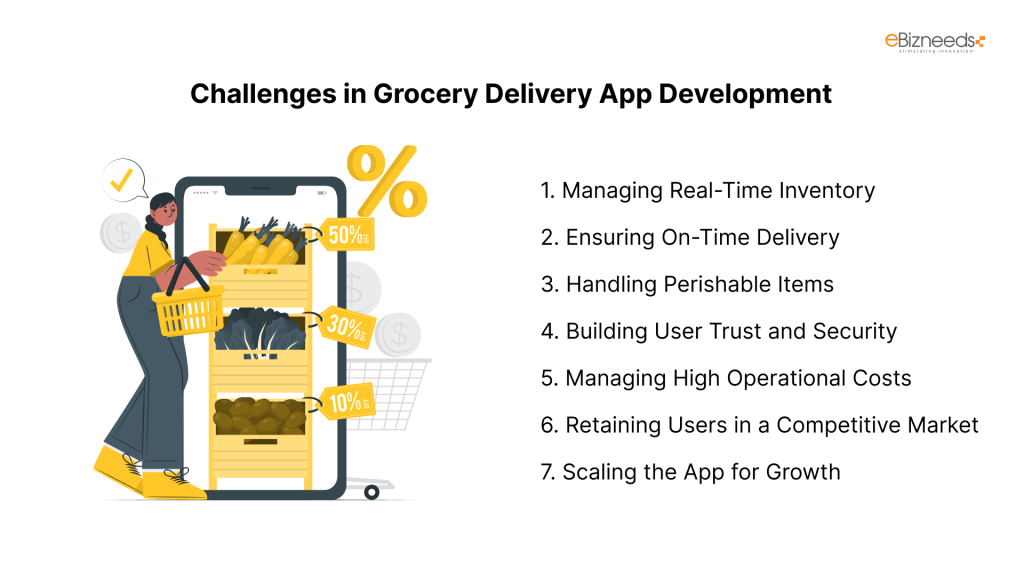


Developing a grocery delivery app comes with its fair share of challenges, ranging from operational complexities to technical hurdles.
However, with the right strategies, these challenges can be effectively addressed.
Here’s a detailed look at the common challenges and practical solutions for overcoming them:
1. Managing Real-Time Inventory
Keeping inventory data accurate and updated across multiple stores is one of the biggest challenges in grocery delivery apps.
Out-of-stock items and incorrect product availability can lead to customer dissatisfaction.
Solution
• Integrate inventory management systems that sync in real-time with partner stores.
• Use IoT-enabled smart shelves to automatically update stock levels on the app.
• Implement AI-driven predictive analytics to forecast demand and avoid stockouts.
2. Ensuring On-Time Delivery
Delays in delivery due to traffic, route inefficiencies, or high demand can negatively impact user experience.
Solution
• Use route optimization algorithms powered by AI and ML to find the fastest delivery paths.
• Implement dynamic delivery scheduling to balance demand and resources during peak times.
• Consider incorporating drones or autonomous delivery vehicles for last-mile delivery in urban areas.
3. Handling Perishable Items
Ensuring the freshness of perishable goods, such as fruits, vegetables, and dairy products, is critical for customer satisfaction.
Solution
• Use temperature-controlled delivery vehicles with IoT sensors to monitor conditions during transit.
• Partner with local stores or warehouses to shorten delivery distances for perishable items.
• Include a “quality check” feature in the app, where users can report damaged or spoiled goods for quick refunds or replacements.
4. Building User Trust and Security
With users sharing sensitive data like payment details and addresses, maintaining security and trust is crucial.
Solution
• Implement secure payment gateways such as Stripe or PayPal with end-to-end encryption.
• Ensure compliance with data privacy regulations like GDPR and CCPA to safeguard user information.
• Use two-factor authentication and SSL certificates to protect login credentials and transactions.
5. Managing High Operational Costs
The cost of logistics, technology, and marketing can strain profitability, especially for startups.
Solution
• Optimize delivery routes and schedules to reduce fuel and labor costs.
• Use a hybrid model of in-house and outsourced delivery teams to manage costs during off-peak times.
• Focus on monetization strategies such as subscription plans, advertisements, and partner commissions to diversify revenue streams.
6. Retaining Users in a Competitive Market
The grocery delivery app market is highly competitive, with major players like Instacart, Amazon Fresh, and Shipt dominating the landscape.
Solution
• Offer personalized experiences through AI-powered recommendations and exclusive discounts.
• Introduce loyalty programs with reward points for frequent users.
• Continuously update the app with new features, such as voice search or gamification, to keep users engaged.
7. Scaling the App for Growth
As user numbers grow, ensuring the app performs smoothly without downtime or lag can be challenging.
Solution
• Use scalable cloud hosting solutions like AWS or Google Cloud to handle high traffic.
• Implement load testing during development to prepare for peak usage scenarios.
• Use microservices architecture to allow independent scaling of features like search or checkout.
By addressing these challenges proactively, your grocery delivery app can deliver a seamless experience for users while ensuring operational efficiency.
The key lies in leveraging advanced technologies and strategic planning to minimize risks and maximize user satisfaction.



eBizneeds – Your Trusted Grocery Delivery App Development Partner
When it comes to building a successful grocery delivery app, choosing the right development partner is critical.
At eBizneeds, as a leading grocery delivery app development company, we specialize in delivering customized solutions tailored to meet your business goals and market demands.
Our team of expert developers brings years of experience in creating innovative and user-friendly grocery delivery apps that are scalable, secure, and packed with features.
Whether you’re a startup looking to enter the market or an established retailer aiming to digitize your services, we have the expertise to help you succeed.
By partnering with eBizneeds, you gain access to cutting-edge technologies, seamless app design, and ongoing support to ensure your app stays ahead in the competitive grocery delivery landscape.
Let us turn your vision into reality and help you transform the way your customers shop.
Conclusion
Developing a grocery delivery app is more than just keeping up with industry trends, it’s about meeting the evolving demands of consumers who value convenience, speed, and quality.
As the market continues to grow, powered by advancements in technology and changing shopping habits, a well-designed app can become a cornerstone of your business strategy.
From understanding the development process to addressing common challenges and embracing innovative technology trends, building a grocery delivery app requires careful planning and execution.
With features like real-time inventory updates, AI-powered recommendations, and seamless delivery tracking, your app can offer users a superior shopping experience while driving significant revenue growth.
FAQs
The cost of developing a grocery delivery app varies depending on the features, complexity, and development region. On average, it can range from $40,000 to $150,000. Basic apps with essential features cost less, while advanced apps with AI integration and custom designs fall on the higher end.
The development timeline depends on the app’s complexity. A basic app may take around 4–6 months, while a feature-rich app can take 6–12 months. This includes market research, design, development, testing, and deployment.
Essential features include user registration, product search, real-time inventory updates, order tracking, secure payment gateways, and push notifications. Advanced features such as AI-powered recommendations, voice search, and subscription plans enhance user experience and retention.
Yes, scalability is key to a successful app. Using technologies like microservices architecture and cloud hosting (AWS, Google Cloud) ensures your app can handle increased traffic and user demands as your business expands.
A grocery delivery app can generate revenue through delivery fees, subscription plans, partner commissions, in-app advertisements, and surge pricing during high-demand periods. Data monetization and licensing the platform to other businesses are also viable options.



Naveen Khanna is the CEO of eBizneeds, a company renowned for its bespoke web and mobile app development. By delivering high-end modern solutions all over the globe, Naveen takes pleasure in sharing his rich experiences and views on emerging technological trends. He has worked in many domains, from education, entertainment, banking, manufacturing, healthcare, and real estate, sharing rich experience in delivering innovative solutions.
